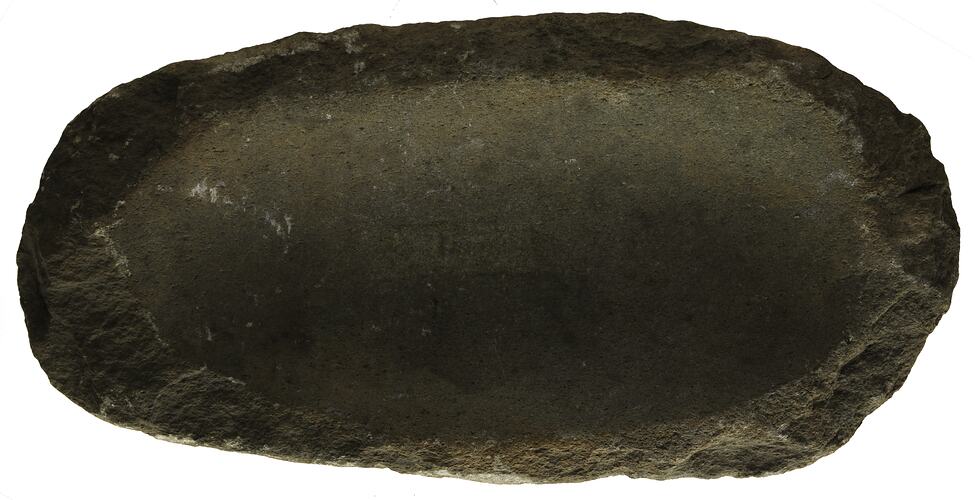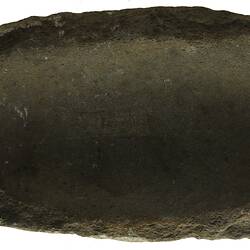Summary
This grinding stone was made and used by the Djab Wurrung peoples.
Stone was the heaviest and most durable material available to First Peoples across Australia. The use of metal was unknown until contact with Indonesian fisherman in the Northern Territory in the 17th century, and later with Europeans across Australia.
Lower grinding stones are slabs of stone that occur in many sizes and shapes, including oval, round and rectangular, which Aboriginal people used for crushing, grinding and pounding different materials. Over time and with use the lower grinding stone would develop a worn depression. The smaller upper stones are flat or rounded and are usually small enough to hold in one hand.
Roots, bulbs, seeds, berries and ochre were some of the things ground between the larger lower stone and smaller upper stone. Many plants had to be processed prior to being consumed. For example, Nardoo seeds had to be ground before being winnowed, and then made into a type of damper before being cooked in an open fire.
Grinding stones were usually found where people lived and camped; the stones were sometimes left upside down, with the grinding surface facing the ground to preserve it from the weather. When moving camp or travelling long distances, heavy grinding stones, weighing several kilograms, were often left behind, hidden in a safe place to be retrieved at a later date.
Physical Description
Small grinding stone. Concave/ground on both sides. Adhesive label reads 'J. Coutts, Kirkella, Victoria'.
Significance
The Djab Wurrung peoples are the Traditional Owners of an area of central Victoria.
The Branbuk Culture Centre in Gariwerd (The Grampians) celebrates Djab Wurrung culture is a contemporary meeting place for Djab Wurrung peoples. Djab Wurrung man Jamie Lowe explains the significance of this centre for his people;
'It's a cultural centre, a meeting place for our people. Five communities across the southwest of Victoria. Something that was traditionally a meeting place where people would have held corroborees here, ceremonies here for thousands of years. Now we have an established building that we can still continue that culture on a contemporary format. We meet here and people come in here. They have weddings here. Have celebrations on that contemporary scale and we still meet here on a traditional format as well and have dances and conversations, and today we're filming a documentary. It's used for all types of purposes.' Jamie Lowe 2016
Reference: http://www.cv.vic.gov.au/stories/aboriginal-culture/seeing-the-land-from-an-aboriginal-canoe/jamie-lowe-interview-part-1-at-fyans-creek-brambuk-djab-wurrung-and-jardwadjali-country/
More Information
-
Object/Medium
Stone artefact
-
Maker
-
Locality
-
Fully Extended
190 mm (Length), 90 mm (Width), 20 mm (Height)
-
Classification
-
Date Made
-
Maker
-
Clan/Language Group
-
Place Made
-
Indigenous Region
-
Keywords
-
Type of item
-
Discipline
-
Category
-
Collecting Areas


